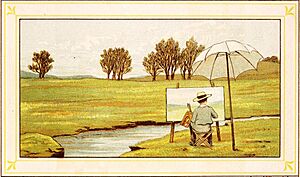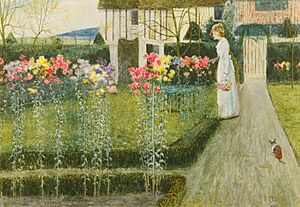John George Sowerby facts for kids
Quick facts for kids
John George Sowerby
|
|
|---|---|
| Born | July 4, 1849 |
| Died | December 14, 1914 (aged 65) |
| Occupation | painter, illustrator, businessman |
| Years active | 1876-1914 |
| Spouse(s) | Amy Margaret Hewison |
| Children |
|
John George Sowerby (1849–1914) was an English artist who painted and drew pictures for books. He was also a businessman from Gateshead. He helped run his family's company, Ellison Glass Works. In the 1880s, this company was the biggest in the world for making pressed glass.
John George Sowerby was the grandson of a famous nature expert named James Sowerby. John George's paintings were shown in important art shows like the Royal Academy of Arts. People generally liked the pictures he drew for children's books.
Sowerby's paintings of nature and flowers were special. They showed a strong, detailed way of looking at things, like the Pre-Raphaelite artists. He also brought new art ideas, from the Arts and Crafts movement, into the glass designs at Ellison Glassworks.
He worked with another painter, H. H. Emmerson, on a children's book called Afternoon Tea in 1880. Most people liked the book. However, some artists, like Kate Greenaway, thought it copied her popular book Under the Window. Sowerby said his pictures were not copies, but just in the same style. The book also had some problems with printing, like colors not lining up correctly.
Later, Sowerby made two other children's books, At Home and At Home Again. These books were decorated by Thomas Crane. A scholar named Roger Dixon said these books were "among the loveliest books ever produced."
Sowerby married Amy Margaret Hewison in 1872. They had one son and five daughters. His daughter Githa Sowerby became a well-known writer for plays and children's books. Her sister, Millicent Sowerby, often drew pictures for Githa's books. Millicent also illustrated famous stories like Alice's Adventures in Wonderland. In her play Rutherford and Son (1912), Githa wrote about a glassworks owner in northern England who had problems with his children. This character was based on her father, John Sowerby.
John George Sowerby passed away on December 14, 1914, in Herefordshire, where he had gone to live after retiring.
The Ellison Glass Works
Sowerby's family had been making glass since the early 1800s. His grandfather, George Sowerby, was a partner in a company called New Stourbridge Glass Works. George's son, John (John George's father), opened a bigger factory called Ellison's Glass Works in 1852. This new factory used machines to make more glass and earn more money.
John George Sowerby grew up learning about the family business. In 1871, at age 22, he started working there as a manager. He also mixed colors for the glass. In the 1870s, he invented new ways to make glass and got patents for them.
In 1880, Ellison Glass Works became a private company. In 1881, John George Sowerby was chosen as the first chairman of the company's board. His time as chairman was short and caused some financial problems for him. He tried making fancy art glass and pottery, which looked nice but lost money. Because of this, John George was removed as chairman in November 1883.
Losing this job caused him to have financial difficulties. He worked at the Glass Works off and on during the 1880s. He left the company completely in the early 1890s. In 1896, he sold all his shares in the company, which meant he lost his main way of earning money. After this, he started to focus on painting full-time.
Books by John George Sowerby
- Afternoon Tea: Rhymes for Children. With H. H. Emmerson. London: Frederick Warne & Co., 1880
- At Home. With Thomas Crane. London: Marcus Ward & Co., 1881
- At Home Again. With Thomas Crane and Eliza Keary. London: Marcus Ward & Co., 1883
- Jimmy: Scenes From the Life of a Black Doll. London: George Routledge & Sons., 1888
- Young Maids & Old China. With F. W. Bourdillon. London: Marcus Ward & Co., 1889
- Rooks and their Neighbours. London: Gay & Bird; Newcastle-on-Tyne: Mawson, Swan, & Morgan, 1895



